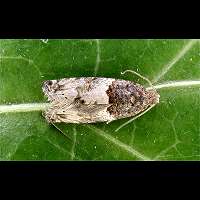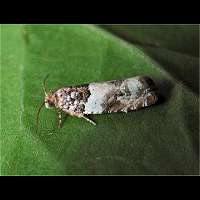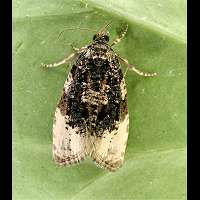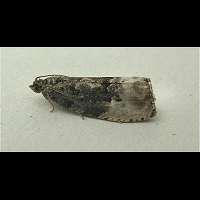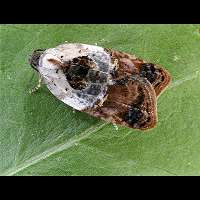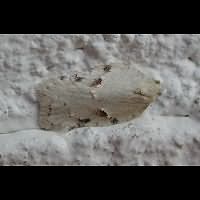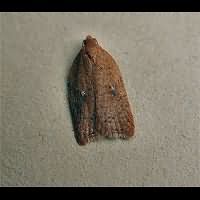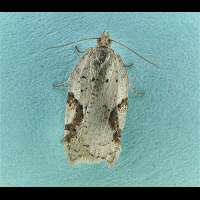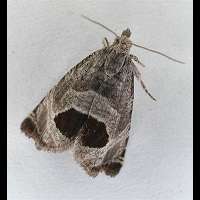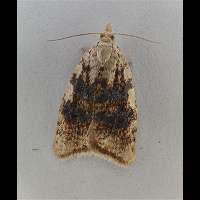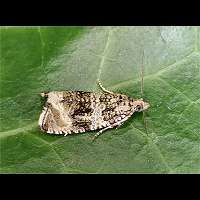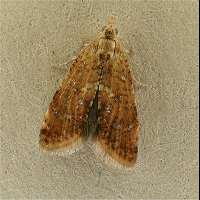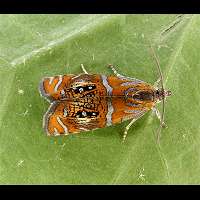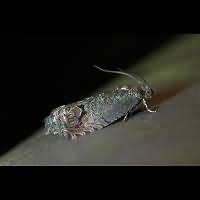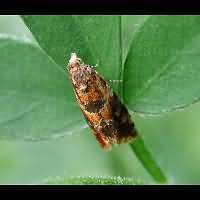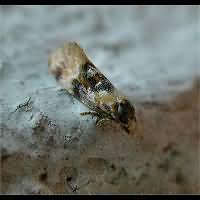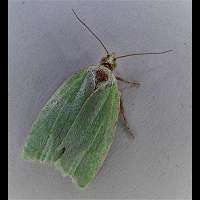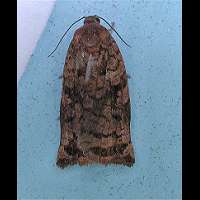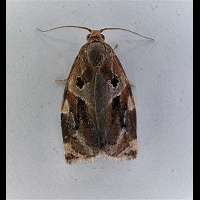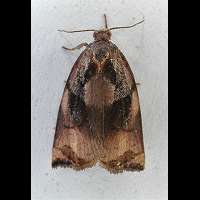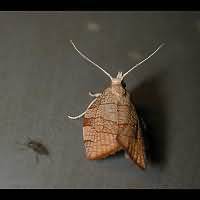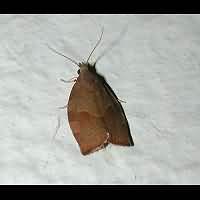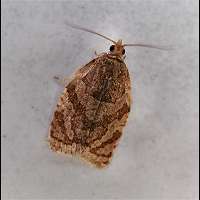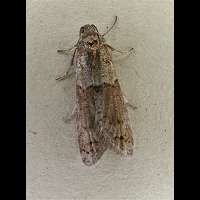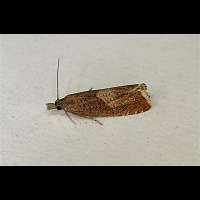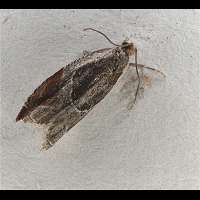[All pictures of garden wildlife on this page are thumbnails. Click on any thumbnail for a large format to be displayed.]
Tortrixes is a family of small moths comprised of some 400 members in the UK. Resting, most species hold their wings like a roof. In this way they look like very small Owlet Moths. Most species have a wingspan between 10 and 20 mm only. The caterpillar often rolls up a leaf and lives a sheltered life inside. Because of this behaviour they are also referred to as Leaf-rolling Moths, especially in the USA. Not all caterpillars roll up leaves though. Some mine leaves in the early stages of life, others bore into stems of plants or leaves. Some species are very difficult to tell apart, but most can be identified, especially when slightly enlarged. There are many very beautiful species among them.
Clicking on "more" in the caption will take you to a page containing much more information on the species and usually more photographs as well.
Clicking on "more" in the caption will take you to a page containing much more information on the species and usually more photographs as well.
Poplar Shoot Borer (Gypsonoma aceriana)
The Poplar Shoot Borer is characterized by the lack of characteristic markings. The head is not whitish. more...
The Poplar Shoot Borer is characterized by the lack of characteristic markings. The head is not whitish. more...
Long-cloaked Marble Hedya ochroleucana
Beautiful Tortrix Moth. It is looking the way it does to imitate a bird's droppings. more...
Beautiful Tortrix Moth. It is looking the way it does to imitate a bird's droppings. more...
Marbled Orchard Tortrix Hedya nubiferana
Some of these Hedya species are very difficult to tell apart. This species is also known as the Green Budworm and scientifically as Hedya dimidioalba. more...
Some of these Hedya species are very difficult to tell apart. This species is also known as the Green Budworm and scientifically as Hedya dimidioalba. more...
Rose Garden Tortrix Acleris variegana
Looks a lot like the negative of the previous species. Resting on a leaf it too looks like a bird's droppings. more...
Looks a lot like the negative of the previous species. Resting on a leaf it too looks like a bird's droppings. more...
Acleris logiana
Small milkish white species with brown markings. Easy identifiable because it has a typical resting position: always very flat to the surface it sits on. more...
Small milkish white species with brown markings. Easy identifiable because it has a typical resting position: always very flat to the surface it sits on. more...
Acleris notana
Extremely variable species. Very similar to the species below and identifiable only when it is dark like this one, for Acleris ferrugana never is this dark. more...
Extremely variable species. Very similar to the species below and identifiable only when it is dark like this one, for Acleris ferrugana never is this dark. more...
Acleris notana / Acleris ferrugana
Whitish with a brown half circle near the upperedge of the wing. You can only tell these species apart by examining the genitals. Even experts often put these two together. more...
Whitish with a brown half circle near the upperedge of the wing. You can only tell these species apart by examining the genitals. Even experts often put these two together. more...
Bramble Shoot Moth Notocelia uddmanniana
Easy to identify because of the big black spot on the wings. more...
Easy to identify because of the big black spot on the wings. more...
Pale Yellow Leafroller Aleimma loeflingiana
In spite of the silver, the Pale Yellow Leafroller is mighty rusty. more...
In spite of the silver, the Pale Yellow Leafroller is mighty rusty. more...
Dark Strawberry Tortrix Celypha lacunana
One of the many species with silvry scales. These may look dramatic, but they actually make the animal quite invisible sitting in a tree or shrub with the sun shining through the leaves. more...
One of the many species with silvry scales. These may look dramatic, but they actually make the animal quite invisible sitting in a tree or shrub with the sun shining through the leaves. more...
Pseudargyrotoza conwagana
Another species with silvry scales. Even more beautiful and quite easily identified. more...
Another species with silvry scales. Even more beautiful and quite easily identified. more...
Chestnut Tortrix Cydia splendana
This species is not unlike some others. Its larvae can be found in wallnuts or chestnuts. more...
This species is not unlike some others. Its larvae can be found in wallnuts or chestnuts. more...
Spruce Tortricid Archips oporana
The chocolate brown Spruce Tortricid is still an unusual Tortrix in the UK. more...
The chocolate brown Spruce Tortricid is still an unusual Tortrix in the UK. more...
Brown Oak Tortrix Archips xylosteana
In the genus Archips we find a number of beautifully marked brown tortrix moths. more...
In the genus Archips we find a number of beautifully marked brown tortrix moths. more...
Chequered Fruit-tree Tortrix Pandemis corylana
The Chequered Fruit-tree Tortrix is a small brown Tortrix that differs from the following two species by the fine lines on the upperwing, the open band and the light shoulders. more...
The Chequered Fruit-tree Tortrix is a small brown Tortrix that differs from the following two species by the fine lines on the upperwing, the open band and the light shoulders. more...
Dark Fruit-tree Tortrix Pandemis heparana
Similar the the species above and below. Doesn't have the fine lines of the species above. The band is closed and usuallu uniformly dark. The shoulders are smaller and less well marked than in the species below. more...
Similar the the species above and below. Doesn't have the fine lines of the species above. The band is closed and usuallu uniformly dark. The shoulders are smaller and less well marked than in the species below. more...
Smaller Tea Tortrix Adoxophyes orana
The Smaller Tea Tortrix, also known as the Summer Fruit Tortrix Moth, is similar to the species above. It lacks the numerous fine lines of the Chequered Fruit-tree Tortrix and has bigger and better marked shoulders compared to the Dark Fruit-tree Tortrix. more...
The Smaller Tea Tortrix, also known as the Summer Fruit Tortrix Moth, is similar to the species above. It lacks the numerous fine lines of the Chequered Fruit-tree Tortrix and has bigger and better marked shoulders compared to the Dark Fruit-tree Tortrix. more...
Tortricodes alternella
A rather dull species, almost an exception in Tortrixes. Quite variable, alas. more...
A rather dull species, almost an exception in Tortrixes. Quite variable, alas. more...
Dichrorampha acuminatana
Dichrorampha acuminatana also looks like a dull one at first sight. A close up reveals many unsuspected details though. more...
Dichrorampha acuminatana also looks like a dull one at first sight. A close up reveals many unsuspected details though. more...
Ancylis unculana
Ancylis unculana may be identified best by looking at its large chocolate brown area near the top of the wing. more...
Ancylis unculana may be identified best by looking at its large chocolate brown area near the top of the wing. more...

© Copyright 1998-2024 gardensafari.net (Hania Berdys)

 English / engels
English / engels  Dutch / nederlands
Dutch / nederlands